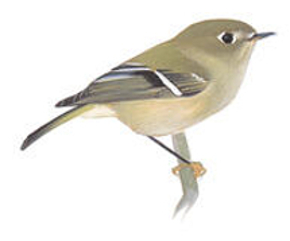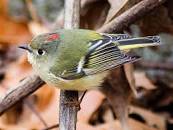Birding: Nature’s Pokémon

High up above the Patapsco River valley, I stand with my father next to a thick bramble. The early October air is crisp, the sun still warm, the leaves beginning to change. In the thicket, a cadre of small, gray birds flits from vine to vine. The plump and distinguished avians leap from branch to branch, assembled for their court-like pageantry.
These kinglets, both Golden-Crowned and Ruby, have flocked to this bush, enticed by a harsh whistling sound, their congregation drawn to my warning call. They jump from branch to branch, as my father and I try to identify and count how many are before us. They mill about in the bramble with their characteristic curiosity, friendly enough towards humans, and are pretty if you can get a good enough look.
The woods are filled with birds: Some friendly as the Kinglet, some shy as the Kingfisher. It’s the season of bird migrations.
***
As the weather changes, birds follow the climate to ensure a stable food supply year-round. They flock North in the spring and summer- heading up to Canada and New England while the weather is warm. As the temperature drops, birds return South, rushing down like water, to the Southern US, Caribbean, and South America.
Migrations make spotting rare birds easier, as there are more birds in concentrated groups, like the massive groups of Kinglets I encountered in the Patapsco.
During migrations, bird enthusiasts themselves flock to the woods, fields, and shores, looking through their binoculars for rare South-bound birds to add to their bird lists. In a way, we’re playing a game of pokémon- trying to catch (or spot) them all.

While we stood looking at the flock of Kinglets (a group of which is often called a Court), a jogger slowed and stopped beside us. Politely, knowledgeably, he asked us if we’d spotted another group of Kinglets.
These birds, usually so rare, were everywhere.
For non-birders, starting to identify birds can be overwhelming. Many birds have similar shapes, sizes, and plumage. Many of them prefer to stay high in the trees, moving with agility between branches, like our Kinglets. Others soar high above us, difficult to see in the sun’s glare. In short, birding can be hard.
An easy way, of course, to use the resources available to birders. Field guides can be a valuable resource, not only showing detailed images of birds, but describing their behavior and song. And in this day and age, there are internet resources that can help birders too.

Cornell University, one of the most notable ornithology labs in the country, created a website and app called eBird, with the specific purpose of helping birders track, find, and share the birds they’ve seen. Birders can communicate with each other, letting the community know which birds are congregating in certain places.
Like a field guide, the app has audio recordings and images to help identify birds. Not only does this help birders, but the site is used by scientists, hoping to track the patterns and populations of species.
In a way, the ability to log bird sightings has truly created the birder’s version of Pokémon-Go.
As we continue on our walk through the woods, we pull out our phones, logging the Kinglets to our bird lists. A Yellow-Bellied Sapsucker flies overhead and we excitedly add it to our lists; it is the first one I’ve been able to see and log in my app, bringing my total up to 83 birds.
All of these resources can make birding easier, but they can only do so much. The real way to start understanding birds is to practice in the wild. While field guides and trackers can help prepare a bird-watcher for the field, experience is still the best teacher.
Go out into the woods, look and listen closely. Peer into the treetops and watch overhead. In time, you’ll start seeing the hidden birds: warblers in the high branches, woodpeckers on the trunks, and sparrows in the brush. It’s a hidden world of life, one which we will only find if we look.


